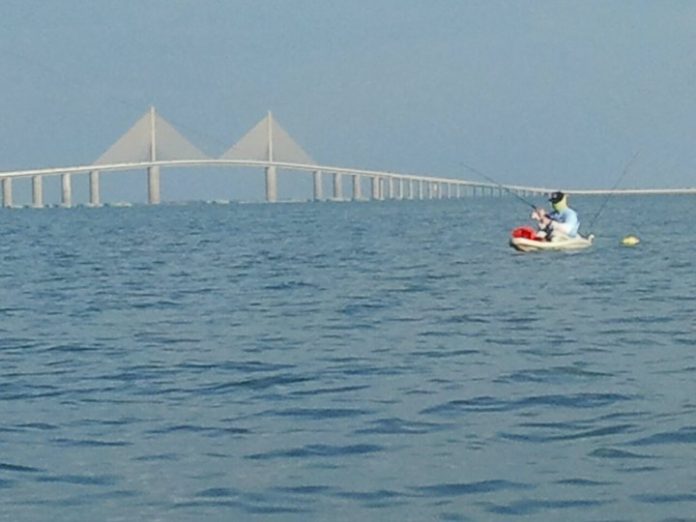Spotted seatrout in the Tampa Region apparently did not get the message that they should be confined to the shallow grass flats as another fine week of trout fishing occurred at the Sunshine Skyway Fishing Piers. Limits of trout were once again common this past week, and many fish had to be released due to size and/or bag limit restrictions. Spanish mackerel seemed to improve in the late afternoon / early evening time frame – especially for anglers fishing live or cut baits. Summer hill tides have begun and the blue crab flush on the North Pier is already in full swing. Tarpon are taking advantage of the crab buffet served-up by these tides as well and telltale gulps are constantly being heard in the darkness on both piers. Mangrove snapper remain good on the night bite and many big sharks are making a visit to the piers. Indeed, one bull shark in the 8 foot range was observed (and filmed) by eager onlookers as the fish circled pier pilings with a big cobia hanging nearby.
Anglers fishing live and cut baits along the artificial reefs & pier pilings were once again rewarded with great catches of spotted seatrout. The fishing method is almost the same as one would traditionally use to pursue mangrove snapper at the piers. A 1 oz. – 2 oz. egg sinker is generally fished above a swivel and a length of 20 lb. – 30 lb. monofilament or fluorocarbon leader material in a traditional bait rig fashion. Black nickel octopus or circle hooks in the 1/0 to 3/0 range are generally on the business end, with hook size being dictated by bait choice. Some anglers will fish ‘knocker-rig’ style, with the weight meeting the eye of the hook, and still others will fish natural baits on a plain jig head.
Trout have been taken on a wide variety of natural baits so far this season, with perhaps the most common choices being scaled sardines, threadfin herring or shrimp. Trout have fairly large mouths, so some anglers are fishing small to medium-sized bait choices whole instead of cutting them into chunks, as they might do for the smaller-mouthed snapper species common at the piers. Small (silver dollar sized) pinfish have been great when fished whole, and much larger pinfish have made for good cut bait options. Some anglers have even deployed chunks of ladyfish with good success. Of course, the added bonus of this trout fishing is that nice mangrove snapper, grunts and flounder are all common by-catches in what has made for some very nice mixed-bag coolers of fine eating fish!
The first spring hill tides of this fishing season began in earnest this past week, and the traditional push of blue crabs, pass crabs & shrimp at the Skyway Piers also arrived like clockwork. The North Pier during an evening outgoing tidal cycle that pushes 2 plus feet of water from Tampa Bay through the pier spans is the ideal time & situation to target for land-based crabbers over the next few months. Arrive early to get your parking spot and arrange your gear, all of which is much easier in the daylight hours. Dip nets with extremely long handles (20 feet +) are the main weapon in this game, but headlamps and spotlights are nearly as crucial. Some anglers construct nets from PVC pipe, pool store supplies and landing nets, but the pier bait shops sell some of the finest long-handle dip nets available anywhere in the region.
A team approach with the use of a spotter can increase your catch – especially if you are identifying crabs before they reach the lighting of the piers. Do not raise the net with each crab if another is quickly approaching – simply shake the crustacean further into the bucket of your net. You might lose a few, but you will perform better numerically over the course of an entire evening. Do not ignore the smaller pass crabs & shrimp that also float by – the pass crabs can make good bait for many fish species and the shrimp are simply delicious. If the North Pier is too crowded, the South Pier will also yield some crabs & shrimp during the same tidal cycles. Visitors should not expect the shear numbers taken on the North Pier, but more room and a relaxed atmosphere can be attractive to some families. Check out publications from the Florida Fish & Wildlife Conservation Commission (FWC) to learn about blue crab size & bag limits, as well as special egg-bearing release requirements.
- The Skyway, Paul Bristow - August 24, 2018
- The Skyway, Paul Bristow - August 17, 2018
- The Skyway, Paul Bristow - August 10, 2018











